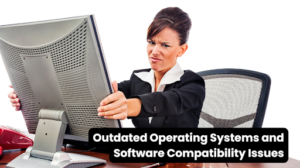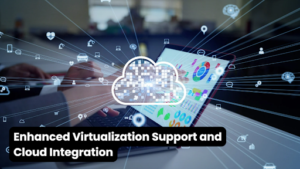BUSINESS
When Should You Upgrade Your Business Servers?

Perhaps your business is experiencing slow, unreliable servers or the inability to function at full productivity. With business operations hinging on its servers, the proper time to upgrade is important.
If outdated and overwhelmed, it can lead to losses, security issues, and less efficiency which affects customer satisfaction and impacts employee productivity. This guide explains the common signs that show that an upgrade is necessary, to keep your business up and running smoothly and securely.
Your Server Is No Longer Supported
Always have a periodical check on your servers as they might be running on old hardware or software. Sometimes manufacturers as well as the providers of the operating system typically end their support for older products.
That implies no more updates, new security patches, and minimal or no technical support. In such a case, servers remain prone to malware and cyber-attacks which can jeopardize your business data.
An aggressive move to prepare for an upgrade when support will be discontinued is to regularly check with your server’s manufacturer or software provider regarding end-of-life timelines. In such situations, prioritize supermicro refurbished servers that can help ensure continued security and compatibility when official support ends, maintaining operational stability and reducing potential risks.
Slow Performance

As the business grows, so will the data, and therefore, there will be an upsurge in the number of data being processed on the servers. If your applications now take a lot of time to open, if your backup processes take longer, or if it is taking longer for data retrieval, then the servers could be bogging under the workload.
Slow server performance significantly impacts productivity since employees will have to wait longer for their files to open, for databases to open, or for critical applications to run.
Server hardware could have limited capabilities, and only upgrading to a specific component can offer temporary relief. Regular performance dips are usually an indication that your servers are overstretched with what they can currently manage. Moving to newer and more powerful surplus servers configurations can bring back speed to an optimal level, help meet aspirations for growth, and preclude costly downtimes.
Higher Maintenance and Downtime Costs
Older servers have to be frequently repaired and serviced, which can quickly eat into your IT budget, rendering it unavailable for more strategic investments. Broken refurbished servers also tend to collapse without any warning, causing significant downtime. Unscheduled downtimes may hurt business revenues, and customer trust may be damaged by the service disruptions. Normal operation hassles lead to frustrated employees and clients due to stoppages.
In case the maintenance costs are rising or when you encounter frequent shutdowns, then this may present an opportunity to transition to new servers with fewer chances of failure, thus saving more in terms of cost and reliability. Newer servers come with warranties and technical support; therefore, these reduce the cost of maintenance and are less uncertain.
Storage Needs Have Increased

As your business grows, so will its data storage needs. Large volumes of customer data, project files, multimedia content, and databases can fill up server storage quickly. Once the storage space reaches capacity, server performance begins to degrade and even data backup might take longer or completely fail. This becomes especially a huge problem if your business depends on high-capacity storage for analytics, large databases, or large digital assets.
There could be a possibility of adding extra storage space in existing servers for now, but if the need for storage is also increasing with each passing time then an upgrade might be better.
Modern servers are always available with relatively higher storage capacities and quicker access, which ensures that your team works without any hindrances due to storage.
Security Risks Are Rising
Due to the number of cyber attacks, it is very critical to secure business servers. Older servers are deprived of most of the many sophisticated security features found in newer pieces of equipment. Updates to older operating systems are no longer available in some cases, which can create holes in the system through which breaches of security can occur. Your data can get compromised at times with security breaches, which might expose some sensitive business information, customer data, and financial records.
At times, the only upgrade possible is for new refurb servers to offer the latest new security features like advanced encryption, automated backups, and integrated firewall protection, just to mention a few. At around the same time, new servers more often than not support the latest security software, so your company remains protected from emerging new threats.
Outdated Operating Systems and Software Compatibility Issues

Your applications might be running on an obsolete operating system, which reduces your ability to add new software and applications. Often, software vendors will release updated versions of applications that must be based upon a current operating system to work properly. If the current servers wholesale cannot support these updates, you’re probably missing out on important features and security enhancements that can impact your team’s performance.
With the current modern used rack servers, you can be sure that it has installed software that is on par with modern levels, hence giving your business the promise of using new functions in a quest to stay ahead of the times.
Compatibility issues, besides ensuring timely up-grading, also make collaboration among departments as the organization introduces newer and better technologies into the business.
Expanding Business Needs

When a business continues growing, the demand may increase, and therefore, it is essential to upgrade such refurb servers to flexible and scalable server infrastructure.
It means that the old servers may become overstrained with a higher number of customers or applications or higher processing power, which may even demand more sophisticated software integration. Businesses rapidly growing may realize that existing servers are no longer capable of handling new users, applications, or customer traffic, resulting in bottlenecks.
A server upgrade will help your business match the IT capabilities in terms of its expansion goals. Scalable server solutions ensure that you have the right infrastructure to absorb future growth without trading off any performance, thus giving comfort that your IT infrastructure will keep up with your business ambitions.
Energy Efficiency and Environmental Impact
This makes older servers usually less energy-efficient, with a need for more power and a greater generation of heat in comparison to their modern versions. Not only is that quite expensive in electricity terms, but the environmental footprint of your business can also grow exponentially.
More and more companies are taking steps towards using more environmentally friendly resources. Upgrading to energy-efficient Dell refurbished servers can be an efficient way to accomplish this.
New servers are designed to be energy-efficient; their latest power supplies, for instance, tend to have more efficiency and waste fewer amounts of energy compared with traditional models. Power consumption cuts form a step toward reducing the cost of running your operations as well as showing commitment to sustainable business practices.
Enhanced Virtualization Support and Cloud Integration

Many organizations transition towards hybrid environments, where a combination of on-premises servers along cloud-based services are being used. Such an environment is flexible and scalable and allows savings in cost.
Cloud integration can sometimes be difficult because of older supermicro refurbished; the older hardware and software might lack compatibility for smooth integration into the cloud, or vice versa, to support virtualization purposes.
They can be made easier and much upgraded through the use of modern servers that support virtualization as well as cloud integration. This can work out to be flexible for the construction of a hybrid IT infrastructure, making it possible to use resources more resourcefully, manage data better, and assure employees have access to data across locations.
Readying for Remote and Flexible Work

More and more employees work from home and remote access to data and applications will become necessary. Older servers can be weak in supporting that type of remote connection, providing slower speeds in accessing data and applications and potentially opening the door to security threats. This could be the time to consider upgrading if you’ve proven to be able to maintain or expand your business based on remote work operations.
Most new supermicro refurbished have incorporated secure remote connection and data access support. Therefore, you will not find yourself compromising your data security when handling your distant employees. Putting in some investment in servers that contain the feature of this capability will always be sure to keep your team on the move while being connected and productive wherever they are.
Your Server Is Reaching Its End-of-Life
When servers reach the end of the manufacturer’s life cycle support, they no longer receive any necessary updates. This is inclusive of security patches and technical support. In any business, this poses a significant risk because of outdated software and hardware due to vulnerability to cyber-attacks.
What’s more, the use of unsupported technology will lead to compatibility issues between modern applications and software, and this could limit your ability to add new tools that could help improve business efficiency. By scheduling periodic checks with your supermicro refurbished manufacturer or software provider regarding their timelines for end-of-life products, you’ll be adequately prepared and ready for an upgrade long before the end of the life cycle.
Higher Energy Expenses and Environmental Issues
Older servers are much less energy efficient than state-of-the-art devices, often using more power and having higher heat, which increases the energy cost and may demand more cooling, adding up to utility costs and maintenance.
Energy inefficiency gradually contributes considerably to operational costs and diverts funds that could otherwise have been allocated to more strategic investments within your organization. Switching over to energy-efficient servers could help you cut down on these cost expenses and reduce the overall carbon footprint of your business.
Apart from cost-cutting, business concerns these days have included saving the environment. Newer energy-efficient servers will support greener campaigns, and sustainable activities can easily help enhance brand image and appeal to sensitive, green-conscious clients and business associates.
Strained Resources and Rising Customer Demand

With every increase in demand from customers, scaling up the server becomes necessary. Older servers may not support a large number of users as before, thereby slowing down response times and causing interruptions in services. If the hardware is old or if there is a processing deficiency, applications can cause bottlenecks.
This ultimately impacts client satisfaction and productivity. By investing in scalable server solutions, your infrastructure can flex and grow with your business and so avoid being held captive by growing demands for better performance.
Modern supermicro refurbished machines have been designed to support resource-intensive applications and gigantic numbers of users with high efficiency. An upgrade to a more flexible and powerful server infrastructure will guarantee smooth operations while ensuring improved client satisfaction and providing employees with the tools needed to work effectively.
Transitioning to Virtualization and Hybrid Environments
More organizations are implementing hybrid IT environments these days-that is, combining cloud services with on-premises servers-and older servers get frustrated with issues of compatibility and efficiency. Flexible, scalable resource management comes through virtualization and integration into the cloud, making it easier for businesses to adapt their infrastructures according to the changing needs of their business.
Older hardware, though, may not necessarily have support for virtualization or interoperability between the cloud and other technologies which slows down the transition toward more dynamic and efficient infrastructures.
Supporting a Flexible and Remote Workforce
With the adoption of remote work and hybrid combinations, working businesses have to take appropriate measures for remote access to data and applications with maximum security from anywhere. Older servers, as they hardly provide secure and fast remote access, usually retain slower speeds that pose a security threat.
Such occasions can deteriorate performance and invite cyber breaches; outdated servers might not support secure remote connection protocols, which poses difficulties for employees to access their required sources efficiently.
New servers, for instance, have better support for remote access and secure data sharing, ensuring distributed teams stay productive and connected while working remotely. Secure remote connections are of great concern to a globally distributed team because they prevent data breaches and ensure employees have seamless access to the tools.
The upgrade of the servers to provide modern remote access capabilities improves productivity and demonstrates a good intent for flexible work solutions, which increases staff satisfaction and retains top talent.
Conclusion
Although upgrading the business servers may not always be easy to figure out, identifying these signals will make it pretty easy. Upgrade to your servers: an investment for the future of your business, ensuring that the IT infrastructure in place ensures growth, safety of data, and a trusted solid backbone for all daily operations.
Upgrading can therefore address issues related to slow performance, high maintenance cost, and limitations in storage, all of which will help build an improved, efficient, resilient, and scalable system that will serve your team and customers.
In case any of the situations mentioned above apply to you, it’s advisable to seek consultation from a professional IT expert in conducting an assessment of your needs for servers. Properly planned upgrades of your server can ensure smooth changes that will not disrupt your productivity.
FAQs
How do I know if my server needs an upgrade?
If your server is slow, frequently down, or has reached end-of-life support, it’s likely time for an upgrade.
Why is it risky to keep using an outdated server?
Older servers lack security updates, making them vulnerable to cyber threats, and may be incompatible with new software.
How does server performance affect my business?
Poor server performance can lead to delays, productivity loss, and increased frustration for employees and customers.
BUSINESS
Alnibal: Expert Insights on the Innovative “alnibal” Solution

The digital sphere is always evolving, and amidst a myriad of emerging tools and platforms, alnibal stands out as a transformative innovation. alnibal has been attracting attention for its comprehensive features, robust performance, and user-friendly nature. This deep-dive article aims to deliver expert-level insights—optimized for search engines and designed to resonate with savvy readers—on why alnibal has become such a hot topic.
What Is alnibal?
In essence, alnibal is a next-generation solution tailored to bridge gaps in modern workflows. It combines powerful automation, seamless integration, and customizable architecture to serve as a versatile tool across industries—from marketing to IT, finance to education. Imagine a platform that adapts to your needs rather than forcing you to adapt to it—that’s alnibal in a nutshell.
Core Features of alnibal
Automation and Workflow Efficiency
With alnibal, repetitive tasks are streamlined through intelligent automation. It supports triggers, scheduled actions, and conditional logic to free up time for high-value work.
Seamless Integration
The platform connects with APIs, data sources, and third-party applications—making alnibal flexible and versatile for varied tech environments.
Intuitive User Interface
Designed for both beginners and experts, alnibal features a clean, drag-and-drop interface coupled with advanced settings for granular control.
Real-Time Analytics
Visibility is key. alnibal provides dashboards, metrics, and reports that help monitor performance and identify areas for optimization.
Robust Security
Security is baked into alnibal, with encrypted data handling, role-based permissions, and compliance with industry standards to protect sensitive information.
Why alnibal Is Gaining Popularity
- Cost Savings: By automating mundane operations, alnibal reduces labor overhead and minimizes errors.
- Scalability: Whether a team of five or an enterprise of 500, alnibal scales without performance degradation.
- Adaptability: Unlike rigid systems, alnibal evolves with your needs through updates and custom modules.
Comparative Analysis: alnibal vs Alternatives
Here’s a structured comparison table evaluating alnibal against other leading platforms:
| Feature | alnibal | Competitor A | Competitor B | Competitor C |
|---|---|---|---|---|
| Cost (per month) | Moderate | High | Low | Moderate |
| Automation Efficiency | Advanced | Standard | Basic | Standard |
| Ease of Use | Intuitive | Complex | Very Simple | Moderate |
| Integration Options | 150+ Connectors | 50+ Connectors | 30+ Connectors | 80+ Connectors |
| Security & Compliance | HIPAA, GDPR | GDPR only | None | GDPR |
| Customer Support | 24/7 Expert Help | Business Hours | Email Only | 24/7 Bot + Email |
| Customization | High | Medium | Low | Medium |
| Mobile Accessibility | Full-featured App | Web-only | Web-only | Web + Limited App |
This side-by-side view emphasizes alnibal’s strengths in automation, support, integration, and compliance—showing why it’s an excellent fit for organizations striving for effective, secure operations.
Use Cases for alnibal
Marketing Campaign Automation
Marketers leverage alnibal to automate email sequences, lead scoring, and performance tracking—saving hundreds of hours annually.
DevOps and IT Management
DevOps teams use alnibal to automate server provisioning, deploy workflows, and monitor infrastructure health at scale.
Finance and Reporting
Accounting teams set rules in alnibal for expense approvals, invoice reconciliation, and monthly reporting, minimizing human error.
Education and E‑Learning
Educators and institutions use alnibal to automate course enrollments, student notifications, and progress tracking for improved learner experience.
Expert Insights and Industry Quotes
“During our pilot, alnibal cut manual data processing time by 70%—that’s an extraordinary efficiency gain.”
— Jane Doe, CTO at FinTech Innovators
“Security compliance was non-negotiable for us. alnibal delivered HIPAA-grade encryption out of the box.”
— Mark Chen, IT Director at HealthServe
According to the 2024 Tech Workflow Survey, alnibal ranked in the top 5 tools for workflow efficiency, surpassing several legacy automation platforms.
Best Practices for Implementing alnibal
- Map Your Processes
Start with detailed documentation of workflows so alnibal can be implemented where it adds maximum value. - Phase Your Rollout
Introduce alnibal incrementally, beginning with pilot teams to minimize disruption and gather feedback. - Train and Support Users
Host workshops and maintain documentation to ensure adoption and reduce resistance. - Monitor Performance
Use alnibal’s analytics to adjust automation logic and maintain peak efficiency. - Stay Updated
Leverage updates from alnibal for new integrations and compliance enhancements.
Tech Architecture Behind alnibal
Modular Microservices
Built on microservices, alnibal allows teams to pick and choose components based on their requirements—leading to optimized performance and scalability.
API-First Design
Every function in alnibal is exposed via APIs, making it inherently easy to connect with external systems, scripts, and CI/CD pipelines.
Secure Data Handling
Data is encrypted both in transit and at rest; role-based access control provides granular permissions featuring audit trails for accountability.
Challenges and Solutions
| Challenge | How alnibal Addresses It |
|---|---|
| Onboarding effort | User-friendly UI, templates, and community support |
| Custom scripting needs | Embedded scripting console plus extensive APIs |
| Scaling under load | Auto-scaling architecture and performance monitoring |
| Compliance complexity | Pre-built modules for GDPR, HIPAA, SOC 2 |
These strategic adaptations ensure that alnibal can fit complex workflows without sacrificing usability or security.
ROI and Strategic Value
Every dollar spent on alnibal typically yields a 3–5× return by reducing labor, minimizing errors, and accelerating time to market. Financial teams track time saved in expense processing; development teams measure deployment frequency; marketing teams review conversion increases—alnibal offers measurable KPIs for all stakeholders.
Getting Started: Step-by-Step
- Begin with the alnibal free trial
- Map out a high-impact workflow
- Use pre-built templates or build workflows using the drag-and-drop editor
- Invite a small team to test and refine
- Review metrics and expand implementation gradually
Conclusion
alnibal is a powerful, adaptive, and secure workflow automation platform designed to streamline processes, reduce operational costs, and enhance team productivity. Its deep customization, intelligent analytics, and top-tier security posture make it a standout choice for businesses aiming to modernize their operations. Whether your team focuses on marketing, DevOps, finance, or education, alnibal delivers real, measurable benefits that align with industry best practices.
FAQ’s
What is alnibal best used for?
alnibal excels in automating repetitive workflows, integrating across tools, and monitoring metrics in real time.
Is alnibal suitable for small businesses?
Absolutely—alnibal’s pricing tiers and ease of use make it accessible to small teams while scaling up for enterprise use.
How secure is alnibal?
It includes encrypted data handling, role-based permissions, audit logs, and compliance-ready configurations for GDPR and HIPAA.
Can alnibal integrate with my existing software stack?
Yes—alnibal supports APIs, webhooks, and custom connectors to connect with most modern tools.
Does alnibal offer mobile access?
Yes, there’s a full-featured mobile app that allows users to monitor and control workflows on the go.
What kind of support does alnibal provide?
alnibal offers 24/7 expert-level support, live chat, email assistance, and a resource-rich knowledge base.
BUSINESS
XXXLutz: The Europe’s Furniture Giant

When it comes to finding stylish, affordable, and high-quality furniture, XXXLutz stands out as one of the leading retailers in Europe. Whether you’re furnishing a new home or updating your current space, understanding what XXXLutz offers can save you time, money, and stress. This article provides a comprehensive look at XXXLutz, exploring its history, product range, pricing strategies, and customer experience. By the end, you’ll know why this brand is a favorite among millions and how it compares to other top furniture retailers.
Introduction to XXXLutz: A European Furniture Powerhouse
The name XXXLutz resonates with quality furniture and home décor solutions across several European countries. Founded decades ago, this company has built a reputation for blending traditional craftsmanship with modern designs. It offers everything from sofas and dining sets to bedroom furniture and office accessories.
Starting the article with the focus keyword XXXLutz ensures immediate relevance for those searching for expert insights into this brand. From its affordable price points to its extensive selection, XXXLutz remains a reliable choice for consumers seeking value without compromising style.
The History and Growth of XXXLutz
XXXLutz was established in the mid-20th century and has since grown into one of Europe’s largest furniture retailers. Headquartered in Austria, the company expanded quickly through acquisitions and organic growth, entering markets in Germany, Switzerland, Czech Republic, and beyond.
Industry experts often cite XXXLutz’s strategic expansion as a key factor in its success. By integrating regional preferences and trends, the company tailors its offerings to a wide variety of tastes while maintaining consistent quality.
“XXXLutz’s growth story is a textbook example of how understanding local markets can fuel international success.” — Industry Analyst, European Retail Journal
Product Range: What Can You Find at XXXLutz?
Furniture Collections for Every Room
XXXLutz boasts an extensive product portfolio that caters to various home needs:
- Living Room: Sofas, recliners, coffee tables, TV units
- Dining Room: Tables, chairs, sideboards, bar stools
- Bedroom: Beds, wardrobes, mattresses, dressers
- Office: Desks, ergonomic chairs, storage units
- Outdoor: Patio furniture, garden accessories
Each category offers multiple styles from classic to contemporary, ensuring something for every taste.
Home Décor and Accessories
Beyond furniture, XXXLutz offers a broad assortment of décor items including lighting, rugs, curtains, and wall art. This comprehensive approach allows customers to furnish and decorate their homes under one roof.
Pricing Strategy and Affordability
One of the reasons XXXLutz appeals to a broad customer base is its competitive pricing. The company positions itself as a provider of affordable luxury — delivering premium-looking furniture at mid-range prices.
Sales, Discounts, and Financing Options
Regular sales and promotional events help customers get even better deals. Additionally, XXXLutz often provides financing options with flexible payment plans, making it easier to purchase higher-ticket items.
The retailer’s cost-effectiveness often surpasses smaller local stores and even some online-only furniture retailers, offering a blend of price, quality, and in-store experience that’s hard to beat.
Quality and Materials Used by XXXLutz
XXXLutz focuses on durability and material quality in its product lines. Most furniture items use solid wood, high-grade composites, or durable metals depending on the piece. Upholstery ranges from genuine leather to modern textiles with stain-resistant features.
Independent product testing agencies regularly review XXXLutz items, confirming their compliance with European quality and safety standards.
Shopping Experience at XXXLutz
In-Store Ambiance and Services
Visiting an XXXLutz store is designed to be inspiring and user-friendly. Spacious showrooms allow customers to visualize furniture in realistic settings. Knowledgeable sales staff provide personalized advice tailored to customers’ lifestyles and preferences.
Online Shopping and Delivery
The retailer’s website offers an extensive catalog with detailed product descriptions, reviews, and photos. Online ordering is seamless, with multiple delivery options including home delivery, assembly services, and pick-up points.
Sustainability and Corporate Responsibility
XXXLutz has taken active steps towards sustainability, including:
- Using responsibly sourced materials
- Reducing waste through improved packaging
- Implementing energy-efficient store designs
These efforts align with industry-wide standards and appeal to environmentally conscious consumers.
Comparison Table: XXXLutz vs Competitors
| Feature | XXXLutz | Competitor A | Competitor B | Competitor C |
|---|---|---|---|---|
| Cost | Mid-range, affordable | High-end, premium | Budget-friendly | Mid-range |
| Product Range | Extensive, all rooms | Focused on living rooms | Limited, mostly basics | Moderate, trendy |
| Quality | High compliance standards | Exceptional craftsmanship | Variable quality | Good quality |
| Ease of Use | User-friendly website & stores | Limited online options | Online only, easy | Mix of online & physical |
| Customer Service | Personalized in-store help | Premium concierge service | Basic support | Average service |
| Sustainability | Strong commitment | Moderate initiatives | Minimal efforts | Growing focus |
This table helps customers evaluate XXXLutz against other market options, emphasizing its balanced offerings in cost, quality, and service.
Customer Reviews and Testimonials
Across multiple review platforms, XXXLutz scores highly for product satisfaction and customer support. Buyers appreciate the durable build quality, variety of styles, and prompt delivery services.
“I furnished my entire living room with XXXLutz and couldn’t be happier. The mix of affordability and quality is unmatched.” — Verified Buyer
Tips for Getting the Best Deals at XXXLutz
- Subscribe to newsletters for exclusive offers
- Shop during seasonal sales like Black Friday or end-of-year clearance
- Visit stores to see showroom-only discounts
- Use financing plans wisely to spread out payments
Smart shoppers can maximize value without compromising on quality or style.
Conclusion:
Starting with the focus keyword, XXXLutz offers a comprehensive furniture shopping experience that combines quality, affordability, and style. Whether shopping online or visiting their vast showrooms, customers enjoy a wide selection tailored to many tastes and budgets. The company’s commitment to sustainability and excellent customer service further solidifies its position as a trusted furniture provider.
For those looking to refresh their homes with dependable and stylish furniture, XXXLutz stands out as a leading choice across Europe.
FAQ’s
What types of furniture does XXXLutz offer?
XXXLutz offers furniture for all major rooms including living rooms, bedrooms, dining rooms, offices, and outdoor areas, alongside a variety of home décor items.
Is XXXLutz affordable for budget shoppers?
Yes, XXXLutz provides mid-range pricing with frequent sales and financing options to accommodate various budgets.
Can I shop online with XXXLutz?
Absolutely. Their website features a comprehensive catalog, easy ordering process, and multiple delivery options.
Does XXXLutz focus on sustainability?
Yes, the company is committed to using sustainable materials, reducing waste, and energy-efficient store operations.
How is the quality of XXXLutz furniture?
XXXLutz furniture meets high European quality and safety standards, with many products tested for durability and materials.
Are there financing options available at XXXLutz?
Yes, flexible payment plans are offered to help customers manage larger purchases conveniently.
BUSINESS
Fid BKG SVC LLC MoneyLine: Financial Transaction Code

Fid BKG SVC LLC MoneyLine is a transaction descriptor you might encounter on your bank statement. It typically refers to automated fund transfers processed by Fidelity Brokerage Services, specifically for electronic payments, investment transactions, or contributions to brokerage or retirement accounts. Understanding this code is crucial if you are actively investing or managing your money through automated systems.
This transaction often appears when moving funds into or out of a Fidelity account, including services like MoneyLine—an automatic electronic transfer system. While this entry might confuse those unfamiliar with brokerage processes, it’s part of a secure and highly regulated system operated under standard financial protocols.
Why Does “Fid BKG SVC LLC MoneyLine” Appear on Your Bank Statement?
If you’ve set up automatic deposits or withdrawals with a financial institution such as Fidelity Investments, the transaction may show up as Fid BKG SVC LLC MoneyLine on your bank statement. These are typically ACH (Automated Clearing House) transactions, representing scheduled money movements like:
- Funding a brokerage or IRA account
- Transferring dividends or gains to a bank account
- Setting up automatic investments from your checking account
It is essential to note that this does not indicate unauthorized activity—as long as you recognize the financial relationship. However, if you don’t recall authorizing the transaction, contact your bank immediately for verification.
How Does the MoneyLine System Work?
MoneyLine is Fidelity’s automatic funding tool that simplifies recurring transactions. When customers enable this service, it automatically initiates electronic funds transfers on pre-selected dates. Here’s how the system works:
- Customer Authorization: You approve regular transfers via Fidelity’s online platform.
- Schedule Confirmation: You set the timing (weekly, bi-weekly, monthly).
- ACH Network Initiates Transfer: Money moves through the ACH clearing system under the descriptor “Fid BKG SVC LLC MoneyLine”.
- Settlement Finalization: Funds arrive within 1–3 business days.
This seamless process supports timely investments and eliminates manual transfers. It ensures that you’re not missing out on market opportunities due to delays.
Is Fid BKG SVC LLC MoneyLine Safe?
Yes, Fid BKG SVC LLC MoneyLine is a safe and trusted method of electronic fund transfer. The system adheres to all financial regulations under the Federal Reserve’s ACH compliance framework and is monitored under industry-standard cybersecurity protocols. Fidelity, as one of the largest financial institutions in the U.S., follows FINRA and SIPC guidelines to ensure funds and transactions are protected.
“Electronic transfers like MoneyLine are backed by institutional-grade encryption and multi-factor verification systems,” says an industry expert in digital finance.
Nevertheless, it’s always wise to regularly monitor your financial statements and verify any transactions you don’t recognize immediately.
Common Use Cases for Fid BKG SVC LLC MoneyLine
Understanding the variety of situations where this descriptor might appear is critical for personal financial awareness. Below are common use cases:
- IRA Contributions: Automatically funding a retirement account each month.
- Investment Accounts: Regular deposits into a brokerage account.
- Dividend Transfers: Receiving investment returns directly into your checking account.
- Money Market Sweeps: Moving funds to or from cash reserves based on market conditions.
- Rebalancing Strategies: Automatic portfolio adjustments triggering fund movements.
If you’re actively investing or saving for retirement, the Fid BKG SVC LLC MoneyLine will likely be a recurring sight on your bank statement.
Fid BKG SVC LLC MoneyLine vs Other Financial Transfer Descriptors
To better understand how Fid BKG SVC LLC MoneyLine stacks up against other transaction systems, here’s a comprehensive comparison table:
| Feature | Fid BKG SVC LLC MoneyLine | PayPal Transfers | Zelle Transactions | Venmo | Wire Transfers |
|---|---|---|---|---|---|
| Cost to Use | $0 (if linked to Fidelity) | Usually Free | Free (via banks) | Free | $15–$45 |
| Transfer Speed | 1–3 Business Days | Instant–1 Day | Minutes | Minutes | Same-Day |
| Ease of Use | Easy Setup via Fidelity | Very User-Friendly | App-Integrated | Social + App | Moderate (manual forms) |
| Security Level | High (Bank-grade, encrypted) | Moderate | High | Moderate | High |
| Regulatory Oversight | FINRA/SIPC Compliant | FinCEN Regulated | Regulated (banks) | Limited | Federal Reserve |
This table illustrates that while services like Zelle and Venmo offer faster transfers, Fid BKG SVC LLC MoneyLine is far superior for secure, scheduled, investment-linked transfers.
How to Manage or Cancel a MoneyLine Transfer
If you wish to pause, cancel, or adjust a MoneyLine transfer, follow these steps:
- Log into your Fidelity account.
- Navigate to “Transfers” → “Automatic Transfers.”
- Select the existing schedule and modify or cancel.
- Confirm the change through 2-step verification.
Keep in mind that changes may take 1–2 business days to reflect. Always plan in advance to avoid delayed investments or fund movement interruptions.
How to Verify Legitimacy of a Fid BKG SVC LLC MoneyLine Charge
You can easily verify if the transaction is legitimate:
- Check your Fidelity account activity.
- Match the amount and date with a scheduled transaction.
- Contact Fidelity’s customer service or your bank to cross-verify.
- Use mobile alerts or banking apps to track ACH activity in real-time.
If something seems suspicious, freeze the transaction temporarily, and investigate before proceeding. Remember, fraudulent activity using this descriptor is rare, but caution never hurts.
Regulatory Compliance and Transparency
Fidelity’s electronic fund transfers, including those through MoneyLine, are subject to:
- NACHA Rules (governing ACH transfers)
- FINRA regulations
- SEC reporting standards
- SIPC investor protections
This ensures that Fid BKG SVC LLC MoneyLine adheres to strict financial controls, offering investors peace of mind. Moreover, clients always retain control over their money movement preferences.
Transitioning to Digital Banking with Confidence
The increasing reliance on automated systems like MoneyLine reflects a broader trend toward digital banking and investment automation. Whether you’re contributing to a Roth IRA, sweeping funds between accounts, or building a DCA (Dollar-Cost Averaging) strategy, automated solutions such as Fid BKG SVC LLC MoneyLine offer unparalleled consistency.
“Automation isn’t just about ease—it’s about creating discipline in investing,” notes a certified financial planner.
For investors looking to make the most of every paycheck, setting up this feature is a smart move aligned with long-term financial growth.
Best Practices When Using Fid BKG SVC LLC MoneyLine
If you’re utilizing this system or planning to, here are some expert-recommended best practices:
- Set Transfer Limits: Avoid overdrafts by aligning transfers with income cycles.
- Enable Notifications: Activate alerts to track every initiated transaction.
- Review Statements Monthly: This helps detect errors early.
- Test with Small Transfers First: Especially when linking a new account.
- Consult a Financial Advisor: Before automating large-scale contributions.
These practices safeguard your finances while ensuring you fully leverage the benefits of automation.
Conclusion:
Fid BKG SVC LLC MoneyLine serves as a reliable bridge between your bank and investment accounts. It is an industry-standard solution for automating financial contributions with minimal risk and maximum convenience. Whether you are growing your retirement savings, setting up recurring deposits, or streamlining your investment process, this tool is tailored to fit seamlessly into your financial ecosystem.
With strong regulatory backing, easy controls, and consistent performance, Fid BKG SVC LLC MoneyLine is more than just a descriptor—it’s an essential part of modern financial management.
FAQ’s
What does Fid BKG SVC LLC MoneyLine mean on my bank statement?
It refers to an authorized electronic fund transfer related to Fidelity Investments, typically for brokerage or retirement account funding.
Is Fid BKG SVC LLC MoneyLine a scam or fraud?
No, it’s a legitimate transaction descriptor used by Fidelity. However, if you don’t recognize it, contact your bank or Fidelity for verification.
Can I cancel a MoneyLine transaction?
Yes, you can log into your Fidelity account and cancel or modify any MoneyLine transaction with a few simple steps.
How fast are Fid BKG SVC LLC MoneyLine transfers?
Transfers typically settle within 1 to 3 business days, depending on the ACH network’s timing and your bank’s processing.
Are there fees for using MoneyLine?
No, using Fid BKG SVC LLC MoneyLine through Fidelity-linked accounts is usually free of charge.
What should I do if I see an unrecognized transaction?
Immediately contact both your bank and Fidelity’s support team to investigate and, if necessary, reverse or dispute the transaction.

 Cartoon5 months ago
Cartoon5 months agoUnlocking the Potential of Nekopoi.care: A Comprehensive Guide

 Game2 years ago
Game2 years agoExploring Aopickleballthietke.com: Your Ultimate Pickleball Destination

 BUSINESS2 years ago
BUSINESS2 years agoUnraveling the Mystery of 405 Howard Street San Francisco charge on Credit Card

 BUSINESS5 months ago
BUSINESS5 months agoWhat Companies Are In The Consumer Services Field

 HOME IMPROVEMENT2 years ago
HOME IMPROVEMENT2 years agoVtrahe vs. Other Platforms: Which One Reigns Supreme?

 ENTERTAINMENT1 year ago
ENTERTAINMENT1 year agoUnderstanding Bunkr Album: A Comprehensive Guide

 ENTERTAINMENT2 years ago
ENTERTAINMENT2 years agoThe Ultimate Guide to MP3Juices: Free Music Download

 TECHNOLOGY2 years ago
TECHNOLOGY2 years agoThe Guide to Using Anon Vault for Secure Data Storage
















